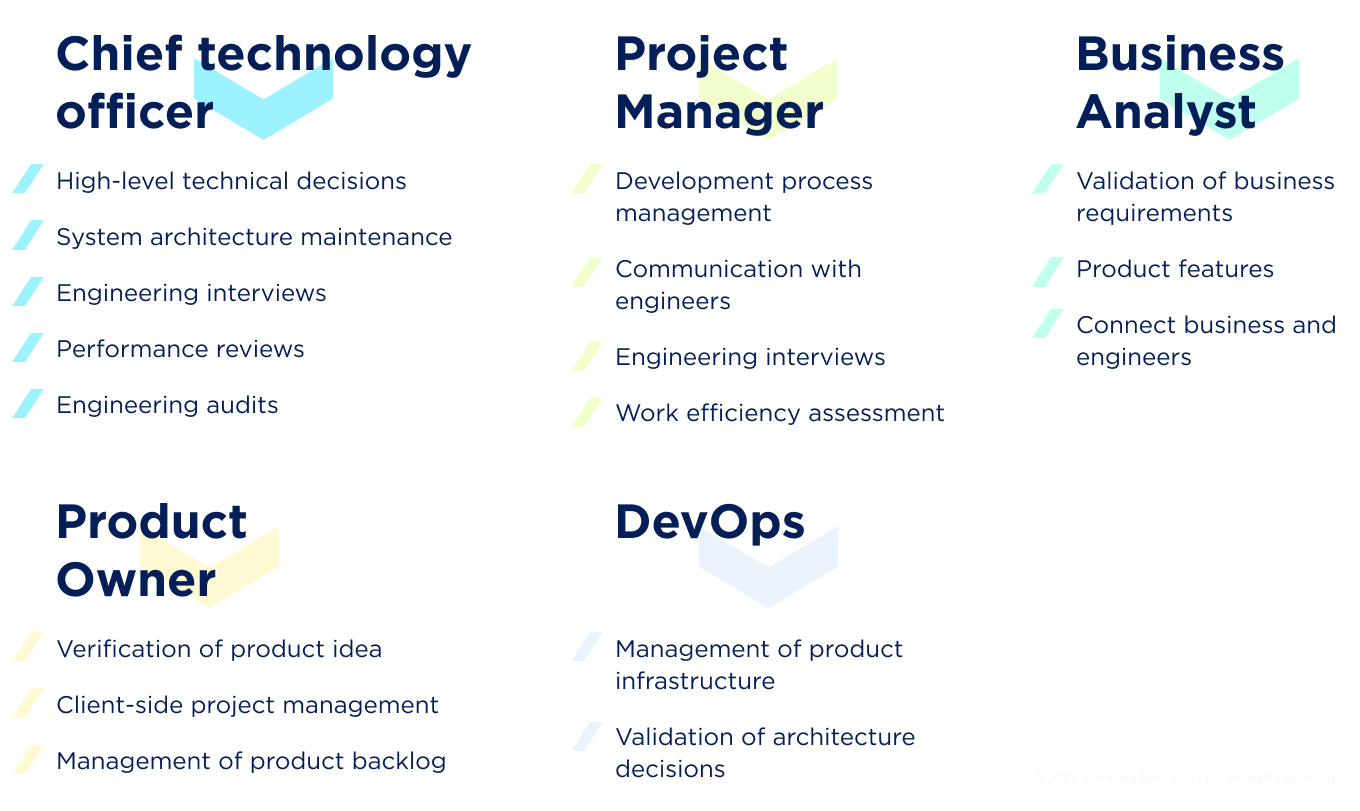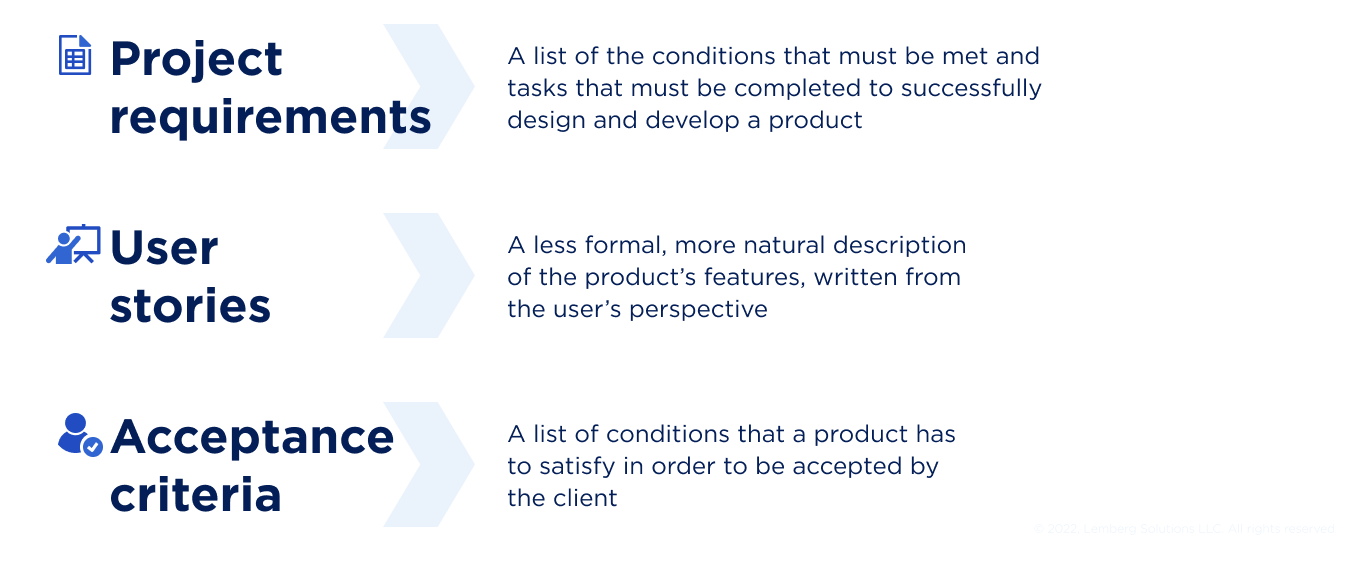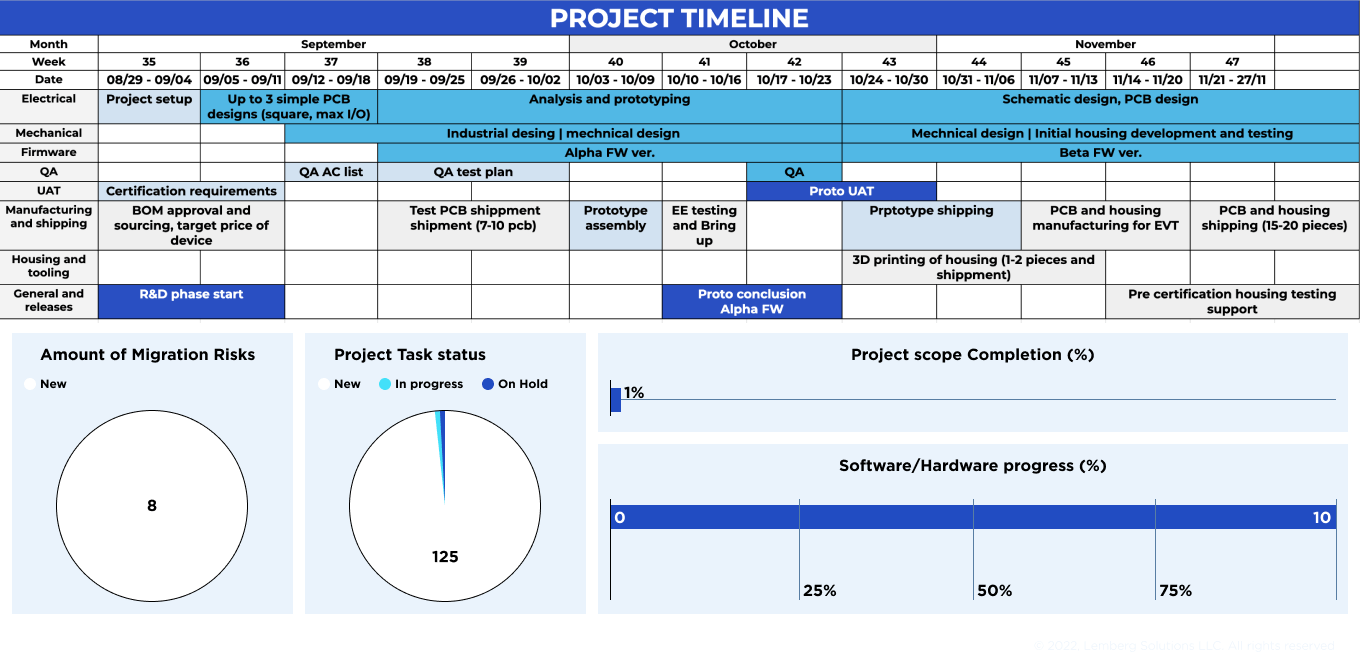Hiring competent software engineers is challenging for many startups. You can have the best idea in the world along with all the funding you need, but make a couple of wrong hires and it all goes down the drain.
While you can always hire a reliable dedicated engineering team, it’s wise to maintain a healthy balance between in-house and dedicated specialists. Based on our experience working with startups, we’ll share our advice on hiring in-house and dedicated engineers for your startup: where to begin, how to know what dedicated developers you need, and whether developers are true professionals.
First, build a tech company organizational structure
Many founders don’t have enough engineering and recruiting experience for building a team for a startup.
That's the reason it is better to start by finding experienced partners who can help you to find developers for a startup and manage product development. Building a tech startup is probably unlike anything you’ve done before, and having the right people by your side from the very beginning will help you build the best business structure for a tech startup.
Chief technology officer (CTO)
The CTO is your go-to technical partner. This is the person who will be accountable for making major decisions about the course of product development, maintaining the system architecture, interviewing engineers, and auditing the engineering team’s work.
Hiring a reliable CTO is quite a tough task. Your CTO needs to be someone whose opinion and expertise you can fully trust. If you’re not sure you can find a suitable professional yourself, consider hiring a CTO as a service. This is a relatively new commodity on the market: companies lend their own CTOs to smaller businesses to provide the help they need. A CTO acquired this way can be a member of your team for as long as you need them — until your product is fully launched on the market or you’ve found an in-house CTO, for instance.
Project manager (PM)
A project manager oversees the development of your product. This specialist encourages the engineers to maintain technical documentation, organizes and manages the development process, communicates directly with developers, you, and all other stakeholders, and handles a whole variety of other tasks.
You need to trust your PM. They must understand and respect your needs while guiding your project through all of the inevitable hurdles. So try to get an in-house PM: this is the person who keeps a steady hand on your project’s pulse, and who is available for communication in person at any time.
However, you can also hire a dedicated PM — highly professional and experienced as well. Just look for companies that provide project managers as part of their dedicated teams.
Business analyst (BA)
A business analyst is accountable for determining the ongoing business needs in order to specify the project requirements. Foremost, BA has to validate the product idea to proceed with the list of features that need to be done. As the features range is ready, the business analyst creates a project roadmap including the product features, project timeline, required tech stack and engineers, and approximate estimation.
Overall, BA connects businesses and engineers ensuring smooth development and overall cooperation predicting potential risks. Startups can consider both types of partnerships with BA - hire an in-house professional or work with an outsourcing specialist entailing close-knit cooperation with the business.
Product manager (product owner)
The product manager or product owner usually works and manages a project from the client side but it doesn't exclude the opportunity to work with an outsourcing product manager.
The role of a product manager on a project is quite similar to a project manager. However, if PM completely focuses on working with the engineering team and managing the execution of tasks according to the project roadmap, then the product manager is more connected with the business and validates and manages the product development process from a client perspective.
You can dedicate a certain range of tasks to our dedicated product manager to review and analyze the client feedback, initiate the product update, and present the product concepts to the team.
DevOps
At first, startups can consider hiring remote DevOps. The company CTO has to provide the DevOps specialist with the project requirements after the IT system is determined, including what parts it will consist of. DevOps is tasked with approximate estimation depending on the number of system users (from 50 to 10,000) and outlining the amount of data that will be processed within this system.
The solution architect creates the base of system parts, and DevOps conducts the first setup iteration for all system components and sets up CI/CD, and environment for development, testing, and production.
For instance, it is better to spend more budget and time on the development process instead of finishing the project quickly as its complicated architecture will require much more expenses on a regular basis.
Summing up, DevOps is an engineer who has deep expertise regarding the software product and development process which allows this professional to validate the following steps, and outline the required features which need to be added or upgraded.

Next, prepare the initial product documentation
Product documentation consists of requirements, user stories, acceptance criteria, and other materials that describe your product very clearly, meaning well-written documentation leaves no space for misinterpretation. You need to outline exactly what each button does and where each screen takes the user to.
With product documentation, you’ll:
- understand what specialists your product needs and when
- know exactly the timeline of the development process
- make sure your product is developed correctly.
Creating and maintaining product documentation is one of the most important responsibilities for a startup. The more meticulous you are in this direction, the easier it will be for you to find developers and make sure that your product gets developed. In fact, even if you have to put the entire startup on hold for a while, well-written documentation will enable you to resume development at any point.
Some project managers take on the task of creating and maintaining product documentation. Other times, PMs only agree to maintain documents and want to see the initial requirements before taking the job. In that case, look for a business analyst (BA).
They’ll take you through several sessions of rigorous interviews to determine your exact expectations for the final product and compose product requirements, user stories, and acceptance criteria based on those expectations.
You don’t, however, need an in-house BA, and you might be better off with a dedicated one: their services are invaluable at the very beginning, but a skilled PM can easily cover the rest.

Read also: Discovery Phase: One Small Step for You, One Giant Leap for Your Project Success
Proceed by setting a project development timeline
A project development timeline visualizes how long it will take to develop each component of the product.
To visually display how the project timeline is created, we want to outline the product development process we follow at Lemberg Solutions.
The project timeline is divided into software development stages:
- Discovery stage — entails collection of product requirements with the engagement of stakeholders and the business analyst to plan and estimate the project
- Project kick-off — the intro meeting for the engineering and client team which aims to determine the goals and value of the project
- Product development process
To create a timeline, a project manager takes the product requirements (which describe the product’s features) and divides them into sizable chunks. The exact division will depend on the PM’s management approach. But no matter how you slice it, a project will always be easier to tackle if you divide it into smaller parts.
Below, you can see the example of the project timeline provided by our project manager Nazar Kohut. The duration and key figures are variable due to the project requirements but the flow is alike.

Now, decide who to hire for the in-house engineering team
This is definitely a tricky decision. Depending on your location, hiring in-house developers can be costly, and their rates won’t necessarily correspond with their professionalism.
If your budget is tight and you’re not sure whether your company can sustain an in-house developer, don’t hire one yet. Start by getting a qualified dedicated team for startup and slowly work your way up to building an in-house team.
Learn more about the development process, discuss every change on a project with your dedicated developers, and regularly talk to your PM and CTO. This approach will ensure that you don’t waste your money on hiring people you don't need at the moment.
Our team also can hold a discovery for your project providing all required documentation and rough estimation. This will simplify the decision of what engineers you should hire in-house and what specialists can be outsourced.
If you do have the opportunity to hire an in-house developer, start with a backend developer. On the majority of projects, backend developers are the ones most familiar with the system structure. They’ll be able to understand your product’s architecture and share it with other developers, whether dedicated or in-house.
Product team
Then, depending on your product’s needs — which you can learn from your CTO and PM — start forming an in-house engineering team. It can consist of:
- UI/UX designers
- Solution architects
- Back-end developers
- Front-end developers
- Firmware developers
- Hardware developers
- iOS developers
- Android developers
- Cross-platform mobile developers
- Data scientists
- QA specialists
- DevOps
If you want to be super secure in preserving the knowledge of your product’s system structure, hire two similarly experienced backend developers to share responsibilities. This way, they’ll be able to back each other up in case of emergency.

Read also: Guide to Managing Your Remote Product Development Team [Client’s Handbook]
Always make sure to hire real professionals
Each startup employee has a huge influence on the company’s success. That’s why you should make sure you hire professional engineers with proven skills.
Ideally, there should be at least two people interviewing each new engineer: your CTO (or an in-house developer if you have one) and your PM. The CTO will make sure that the developer knows their stuff, while the PM will see that they fit with the rest of the team. However, even though teamwork is beyond important in software and hardware development, this doesn’t necessarily mean that all engineers should be open and easygoing.
Although there are many articles that define good software engineers based on their communication skills, proactivity, supportiveness, and ability to propose amazing ideas, the typical real-life developer is far from this. What defines a great developer is:
- technical expertise
- responsibility for their work
- respect for their colleagues.
A great developer should perform their PM’s tasks diligently. Otherwise, your project will struggle to be successful. These are the people you should really be looking for, not just someone who’s good at selling themselves during interviews.

Tech hiring challenges and possible solutions
We want to share the hiring challenges we faced and tell the solutions we succeeded to get. Further, you can read about the common difficulties you may struggle with while hiring tech specialists for your startup team
Costly hourly rates for required expertise
The majority of tech startups have limited budgets for building engineering teams, in-house or remotely. It causes the possible challenge of hiring software engineers with specific knowledge and skills whose hourly rates can be much higher than you planned. These cases are more typical of in-house engineers.
A solution is quite simple, you just need to focus on outsourcing engineering market that offers a broad variety of developers, expertise, skill sets, and hourly rates.
You can hire 1-2 high-level developers who will assign tasks to involved developers with lower qualifications and expertise.
Limited talent pool due to the rare technology
Due to the rare technology requirements for your product development, the tech talent pool becomes narrower which tightens the hiring process and therefore delays the project timeline.
The outsourcing development market is fully packed with engineers you may need. So when looking for engineers for your startup, consider the remote type of cooperation with software developers which broadens the choice.
CTO and CEO may have their own vision of how the product needs to be built, what technologies to use, and so on. For example, you decide to develop a mobile app based on React Native, which causes the issue with a complicated and durable hiring process after the product launch due to lacking professionals in the area. Thus, it delays the whole product development adding more expenses because of the wrongly selected tech stack.
Market competition
Hunting a really good professional becomes challenging due to the huge variety of software companies with open job positions. Your task is to confidently highlight the values and perks of working with your startup engineering team.
Find dedicated engineers at Lemberg Solutions
Lemberg Solutions has a lot of experience working with both startups and established businesses. We mentor at many European startup accelerators. Startups are the future, and we want to help them thrive. We provide solutions that don't require huge investment for software product maintenance, choosing the technologies that are in demand on the market.
If you have a startup idea and are looking for a professional development team, send us a quick message. We could be the ones to help you turn your idea into reality!



